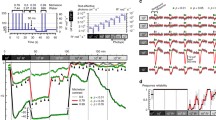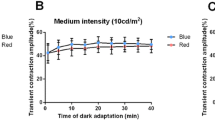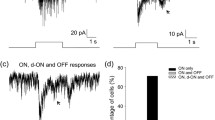Abstract
The ability to phase shift and entrain in response to light is spared in retinally degenerate mice (rd/rd). In the present work, fewer retinally degenerate C57BL/6 mice than wildtypes entrained in dim lights, suggesting that rods and/or cones contribute toward entrainment even though they are not necessary. Thresholds for entrainment appear to be a more sensitive test of deficits in entrainment than phase shifts in response to light pulses.



Similar content being viewed by others
Abbreviations
- DD:
-
continuous darkness
- LD:
-
light-dark
- rd/rd :
-
retinally degenerate
- tau :
-
free-running period
References
Aggelopoulos NC, Meissl H (2000) Responses of neurones of the rat suprachiasmatic nucleus to retinal illumination under photopic and scotopic conditions. J Physiol (Lond) 523:211–222
DeCoursey PJ (1986) Light-sampling behavior in photoentrainment of a rodent circadian rhythm. J Comp Physiol A 159:161–169
Edelstein K, Mrosovsky N (2001) Behavioral responses to light in mice with dorsal lateral geniculate lesions. Brain Res 918:107–112
Edgar DM, Martin CE, Dement WC (1991) Activity feedback to the mammalian circadian pacemaker: influence on observed measures of rhythm period length. J Biol Rhythms 6:185–199
Foster RG, Provencio I, Hudson D, Fiske S, De Grip W, Menaker M (1991) Circadian photoreception in the retinally degenerate mouse (rd/rd). J Comp Physiol A 169:39–50
Freedman MS, Lucas RJ, Soni B, von Schantz M, Muñoz M, David-Gray Z, Foster R (1999) Regulation of mammalian circadian behavior by non-rod, non-cone, ocular photoreceptors. Science 284:502–504
Helfrich-Förster C, Winter C, Hofbauer A, Hall JC, Stanewsky R (2001) The circadian clock of fruit flies is blind after elimination of all known photoreceptors. Neuron 30:249–261
Meijer JH, Rusak B, Gänshirt G (1992) The relation between light-induced discharge in the suprachiasmatic nucleus and phase shifts of hamster circadian rhythms. Brain Res 598:257–263
Mistlberger RE, Holmes MM (2000) Behavioral feedback regulation of circadian rhythm phase angle in light-dark entrained mice. Am J Physiol 279:R813–R821
Mrosovsky N (1999) Further experiments on the relationship between the period of circadian rhythms and locomotor activity levels in hamsters. Physiol Behav 66:797–801
Mrosovsky N, Foster RG, Salmon PA (1999) Thresholds for masking responses to light in three strains of retinally degenerate mice. J Comp Physiol A 184:423–428
Pittendrigh CS, Daan S (1976) A functional analysis of circadian pacemakers in nocturnal rodents. J Comp Physiol A 106:223–252
Provencio I, Wong S, Lederman AB, Argamaso SM, Foster RG (1994) Visual and circadian responses to light in aged retinally degenerate mice. Vision Res 34:1799–1806
Ralph MR, Mrosovsky N (1992) Behavioral inhibition of circadian responses to light. J Biol Rhythms 7:353–359
Schantz M von, Provencio I, Foster RG (2000) Recent developments in circadian photoreception: more than meets the eye. Invest Ophthalmol Vis Sci 41:1605–1607
Stanewsky R, Kaneko M, Emery P, Beretta B, Wager-Smith K, Kay SA, Rosbash M, Hall JC (1998) The cry b mutation identifies cryptochrome as a circadian photoreceptor in Drosophila. Cell 95:681–692
Weinert D, Weiss T (1997) A nonlinear interrelationship between period length and the amount of activity-age-dependent changes. Biol Rhythm Res 28:105–120
Yamada N, Shimoda K, Takahashi K, Takahashi S (1990) Relationship between free-running period and motor activity in blinded rats. Brain Res Bull 25:115–119
Yoshimura T, Nishio M, Goto M, Ebihara S (1994) Differences in circadian photosensitivity between retinally degenerate CBA/J mice (rd/rd) and normal CBA/N mice (+/+). J Biol Rhythms 9:51–60
Acknowledgements
I thank Peggy Salmon, Sonja Banjanin and Christine Tenk for help, and Russell Van Gelder for comments. Naomi Ihara kindly supplied mice. Support came from the Canadian Institutes of Health Research. These experiments were carried out in accordance with the guidelines of the Canadian Council on Animal Care.
Author information
Authors and Affiliations
Corresponding author
Rights and permissions
About this article
Cite this article
Mrosovsky, N. Contribution of classic photoreceptors to entrainment. J Comp Physiol A 189, 69–73 (2003). https://doi.org/10.1007/s00359-002-0378-7
Received:
Revised:
Accepted:
Published:
Issue Date:
DOI: https://doi.org/10.1007/s00359-002-0378-7




